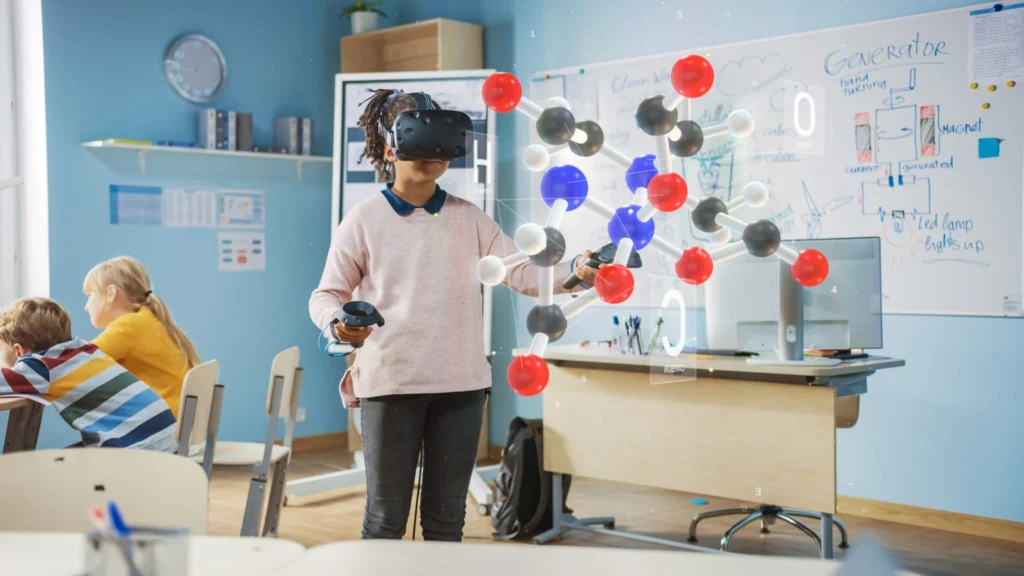Exploring the Potential of Augmented Reality in Education is a topic that has gained significant attention in recent years. Augmented reality, or AR, is a technology that superimposes digital information onto the real world, providing an interactive and immersive experience for users. In the field of education, AR has the potential to revolutionize the way students learn by creating engaging and interactive learning environments. By integrating digital content into the physical world, AR can enhance students’ understanding of complex concepts and make learning more enjoyable and effective. As educators and researchers continue to explore the potential of AR in education, the possibilities for its application in the classroom are becoming increasingly clear.
Augmented Reality in Education has the potential to transform traditional teaching methods by providing a more interactive and immersive learning experience for students. This innovative technology allows students to visualize abstract concepts in a tangible way, making it easier for them to grasp complex ideas. Furthermore, AR can also cater to different learning styles, offering personalized and adaptive learning experiences for students. Additionally, the use of AR in education has the potential to bridge the gap between theoretical knowledge and real-world applications, preparing students for the demands of the modern workforce. As educators and policymakers continue to explore the potential of AR in education, it is clear that this technology has the power to revolutionize the way students learn and engage with educational content.
Enhancing Learning Experience
Augmented reality has the potential to revolutionize the way students learn by providing an immersive and interactive learning experience. By superimposing digital information onto the real world, AR technology can bring abstract concepts to life, making it easier for students to understand and retain information. For example, students studying biology can use AR to visualize and interact with 3D models of cells, organs, and biological processes, allowing for a more engaging and effective learning experience.
Furthermore, AR can cater to different learning styles and preferences, offering personalized and adaptive learning experiences. Visual and kinesthetic learners can benefit from hands-on AR simulations, while auditory learners can engage with AR-enhanced audio content. This versatility in catering to diverse learning needs can lead to improved student engagement and academic performance.
Fostering Collaboration and Communication
AR technology can facilitate collaborative learning experiences by enabling students to interact with each other and their environment in new ways. For instance, students can work together on AR-enhanced projects and presentations, fostering teamwork and communication skills. Additionally, AR can connect students from different locations through shared virtual environments, promoting global collaboration and cultural exchange.
Moreover, AR can enhance communication between educators and students by providing innovative ways to deliver instructions and feedback. Teachers can use AR to create interactive lessons and tutorials, while students can use AR to demonstrate their understanding of concepts through immersive presentations and demonstrations. This can lead to more effective communication and a deeper understanding of the subject matter.
Real-World Applications and Experiential Learning
Augmented reality can bridge the gap between theory and practice by allowing students to apply their knowledge in real-world scenarios. By overlaying digital information onto the physical environment, AR can create immersive simulations and training experiences. For example, students studying architecture can use AR to visualize and manipulate virtual building designs within the context of real-world spaces, gaining practical insights and skills.
Furthermore, AR can facilitate experiential learning by enabling students to explore historical sites, scientific phenomena, and cultural artifacts in augmented reality. This hands-on approach to learning can deepen students’ understanding and appreciation of various subjects, making education more engaging and memorable.
Accessibility and Inclusivity
AR technology has the potential to make education more accessible and inclusive for students with diverse needs and abilities. By providing interactive and customizable learning experiences, AR can accommodate different learning styles, preferences, and physical abilities. For example, students with visual impairments can benefit from AR-enhanced audio descriptions and tactile feedback, while students with cognitive disabilities can engage with interactive AR content tailored to their individual needs.
Additionally, AR can break down geographical barriers and provide access to high-quality education for students in remote or underserved areas. By leveraging AR technology, educators can deliver immersive and interactive learning experiences regardless of physical location, thereby promoting inclusivity and equal opportunities in education.
Practical Skills Development
Augmented reality can facilitate the development of practical skills by providing hands-on training and simulations in various fields. For instance, students pursuing vocational or technical education can use AR to practice real-world tasks and procedures in a safe and controlled environment. This can lead to improved skill acquisition and readiness for the workforce.
Furthermore, AR can support the development of critical thinking, problem-solving, and decision-making skills by presenting students with complex and interactive scenarios. By engaging with AR-enhanced simulations and challenges, students can develop their analytical and creative abilities, preparing them for success in their future careers.
Engagement and Motivation
Augmented reality has the potential to enhance student engagement and motivation by making learning more interactive, immersive, and enjoyable. By incorporating gamification elements and interactive storytelling, AR can create compelling learning experiences that captivate students’ attention and drive intrinsic motivation. This can lead to increased participation, enthusiasm, and a positive attitude towards learning.
Moreover, AR can spark curiosity and exploration by providing students with interactive and experiential learning opportunities. By allowing students to discover and manipulate digital content in the real world, AR can ignite a sense of wonder and curiosity, fostering a lifelong love for learning and discovery.
Cost-Efficiency and Resource Optimization
Augmented reality can offer cost-effective solutions for educational institutions by reducing the need for physical resources and specialized equipment. Through AR-enhanced simulations and virtual experiments, schools and universities can minimize the costs associated with traditional laboratory setups and equipment maintenance. Additionally, AR can streamline the creation and distribution of educational content, reducing the reliance on printed materials and physical resources.
Furthermore, AR can optimize the use of instructional time by providing efficient and targeted learning experiences. With AR technology, educators can deliver complex concepts in a more digestible and engaging manner, maximizing the effectiveness of instructional time and reducing the need for repetitive explanations.
Ethical and Privacy Considerations
As augmented reality becomes more integrated into educational settings, it is essential to address ethical and privacy considerations to ensure the responsible use of AR technology. Educators and developers must prioritize the protection of students’ personal data and privacy rights when implementing AR solutions in the classroom. Additionally, it is important to consider the potential impact of AR on students’ mental and emotional well-being, ensuring that AR experiences are designed with empathy and ethical considerations in mind.
Furthermore, educators should promote digital citizenship and responsible use of AR technology, equipping students with the knowledge and skills to navigate the ethical challenges and implications of augmented reality. By fostering a culture of digital ethics and responsible AR usage, educational institutions can ensure that AR technology is leveraged in a way that respects the rights and well-being of all students.
| Exploring the Potential of Augmented Reality in Education |
|---|
| Augmented Reality (AR) can enhance learning experiences by overlaying digital information onto the real world. It can be used to create interactive and immersive educational content, making learning more engaging and effective. AR can be applied in various subjects such as history, science, and mathematics, allowing students to visualize and interact with complex concepts. Furthermore, AR can provide personalized learning experiences and help students develop critical thinking and problem-solving skills. |
Augmented Reality has the potential to revolutionize education by providing immersive and interactive learning experiences that can enhance understanding and retention of complex concepts.



